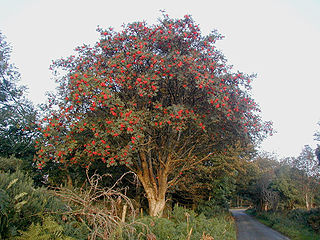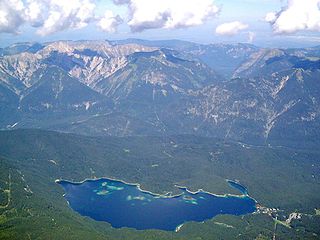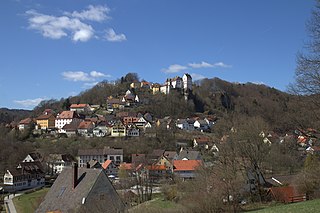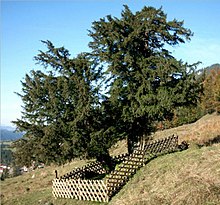
General Sherman is a giant sequoia tree located at an elevation of 2,109 m (6,919 ft) above sea level in the Giant Forest of Sequoia National Park in Tulare County, in the U.S. state of California. By volume, it is the largest known living single-stem tree on Earth.

Sorbus aucuparia, commonly called rowan and mountain-ash, is a species of deciduous tree or shrub in the rose family.

The Alte Pinakothek is an art museum located in the Kunstareal area in Munich, Germany. It is one of the oldest galleries in the world and houses a significant collection of Old Master paintings. The name Alte (Old) Pinakothek refers to the time period covered by the collection—from the fourteenth to the eighteenth century. The Neue Pinakothek, re-built in 1981, covers nineteenth-century art, and Pinakothek der Moderne, opened in 2002, exhibits modern art. All three galleries are part of the Bavarian State Painting Collections, an organization of the Free state of Bavaria.

Athletes from East Germany competed at the 1972 Summer Olympics in Munich, West Germany. 297 competitors, 231 men and 66 women, took part in 161 events in 18 sports.

Taxus baccata is a species of evergreen tree in the family Taxaceae, native to Western Europe, Central Europe and Southern Europe, as well as Northwest Africa, northern Iran, and Southwest Asia. It is the tree originally known as yew, though with other related trees becoming known, it may be referred to as common yew, European yew, or in North America English yew. It is a woodland tree in its native range, and is also grown as an ornamental tree, hedge or topiary. The plant is poisonous, with toxins that can be absorbed through inhalation, ingestion, and transpiration through the skin. Consuming any part of the tree, excluding the aril, can be deadly and the consumption of even a small amount of the foliage can result in death.

Eibsee is a lake in Bavaria, Germany, 9 km southwest of Garmisch-Partenkirchen and roughly 100 km southwest of Munich. It is 973.28 metres (3,193.2 ft) above sea-level and its surface area is 177.4 hectares. It is at the northerly base of the Zugspitze, Germany's highest mountain. The lake lies within the municipality of Grainau and is privately owned.

The Reinberg Lime is a roughly 1,000-year-old lime tree by the village church in Reinberg in the German district of Vorpommern-Rügen.

The lime tree of Kaditz is a natural landmark situated in the churchyard of Emmaus Church in Kaditz, a district of Dresden in Saxony, Germany. The large-leaved lime tree is 20 metres (66 ft) high and is estimated to be between 500 and 1,000 years old. The girth of the trunk is about 10 metres (33 ft). In 1818 the tree was badly damaged by a huge fire in the village, which caused the trunk to split in two. It developed an abnormal growth to compensate for the damage done by the fire. This lime tree has often been written about and depicted, especially in Germany, and has also been used as a case study in dendrology, the science of trees and wooded plants. With its large girth it was ranked among the biggest lime trees in Germany even in the 19th century. The Kaditz Lime is also said to have served as a kind of pillory in the Middle Ages. The German Tree Archive includes it in its list of the most significant trees in the nation, in which the most important criterion is the girth of the trunk measured at a height of 1 metre.

Egloffstein Castle is a former high mediaeval, aristocratic castle, that stands immediately west of the eponymous village of Egloffstein in the Upper Franconian county of Forchheim in the German state of Bavaria.

The King Ludwig Oak is an oak tree recognised as a natural monument in the Staatsbad Brückenau, a state-run spa and park two kilometres (1.2 mi) west of Bad Brückenau in the German state of Bavaria. The German Tree Archive counts the oak among the trees of national importance.

The Schmorsdorf lime tree is a natural monument located in the center of Schmorsdorf, Müglitztal, in the Saxony district of Sächsische Schweiz-Osterzgebirge, Germany. This large-leaved linden is estimated to be 400 to 800 years old. The circumference of its trunk is about 11 meters, and it stands at a height of around 24 meters. The tree gained historical significance during the Thirty Years' War and was first mentioned in writing around 1630 due to its impressive size. Notably, the renowned pianist and composer Clara Schumann visited the Linden Tree multiple times between 1836 and 1849. In her honor, the Linden Museum, which opened next to the tree in 2006, was named after her and remains the only museum of its kind in Germany. The Schmorsdorf lime tree has been recognized by the Deutsche Baumarchiv as a "National Bedeutsamen Bäumen (NBB)", with its trunk circumference serving as the primary selection criterion for this distinction.

The natural monument Kasberger Linde, also known as Kunigundenlinde or Franzosenlinde, is a summer lime tree (Tilia platyphyllos) located on the outskirts of the Gräfenberg district of Kasberg in the Forchheim district. In the vicinity of the tree, court days were presumably held during the Middle Ages. Estimates suggest that the lime tree is between 600 and 1000 years old, and it has been officially recognized as a natural monument by the Lower Nature Conservation Authority of the Forchheim district since at least 1976. Adjacent to the ancient Kasberger Linde stands another lime tree, approximately 150 years old.

The Tanzlinde, also known as the Tausendjährige Linde or Dorflinde, is a summer lime tree (Tilia platyphyllos) located in Effeltrich, Upper Franconia, on the western edge of Franconian Switzerland. Positioned on the village square across from the fortified church, the lime tree has held a significant role as a central gathering, assembly, and judicial site for centuries. Throughout the 19th and 20th centuries, it also served as a venue for festivals and dances. Notably, the tree's growth features a distinctive flat-oval crown, a result of historical bast extraction for the cultivation of fruit trees. The lime tree in the Franconian region is often seen as the most beautiful among many village lime trees. Many tales, stories, and legends are attributed to the lime tree due to its varied life.

The Linde in Schenklengsfeld, also known as the Schenklengsfeld Dorflinde or Riesenlinde, is a thousand-year-old linden tree and is considered one of the oldest trees in Germany. This large-leaved lime tree is located in Schenklengsfeld, approximately ten kilometers southeast of Bad Hersfeld in the eastern Hessian district of Hersfeld-Rotenburg. Throughout its history, this tree served as a court lime tree, where legal proceedings and gatherings took place for several centuries. Additionally, a pillory was constructed near the tree for carrying out sentences.

The Babisnau poplar is a black poplar (Populus nigra) located near Babisnau, a district of the municipality of Kreischa in Saxony in Germany. It stands prominently on a plateau south of Dresden. It was planted in 1808 by Johann Gottlieb Becke, a landowner from Babisnau, as a border tree marking the boundary of his property. This tree has held the status of a natural monument since 1936. Over the years, it has endured significant crown damage due to strong storms in 1967 and 1996. The poplar currently stands at a height of 17.3 meters with a trunk circumference of 5.1 meters.

The Femeiche, formerly known as Rabenseiche, Ravenseiche, or Erler Eiche, located in Erle within the North Rhine-Westphalian district of Borken, is one of Germany's oldest oaks, estimated to be between 600 and 850 years old. This English oak (Quercus robur) stands near the parish church.

The Royal Oak is a natural monument on the outskirts of Volkenroda, a district of Körner, in the Unstrut-Hainich-Kreis in Thuringia, Germany. The English oak is more than 600 years old and has a trunk circumference of about 9.5 meters. The presumed age of the oak was determined by taking drill cores from the trunk and ring counts from a broken branch. It was previously assumed that the location of the oak was an old Germanic Thing site. However, more recent research suggests that the oak grew in a medieval Hutewald forest.

The Grave Oak is a striking old specimen of the pedunculate oak in Nöbdenitz in Thuringia. There is a grave site in the tree's hollow trunk.




















